Äîêóìåíòàöèÿ è îïèñàíèÿ www.docs.chipfind.ru
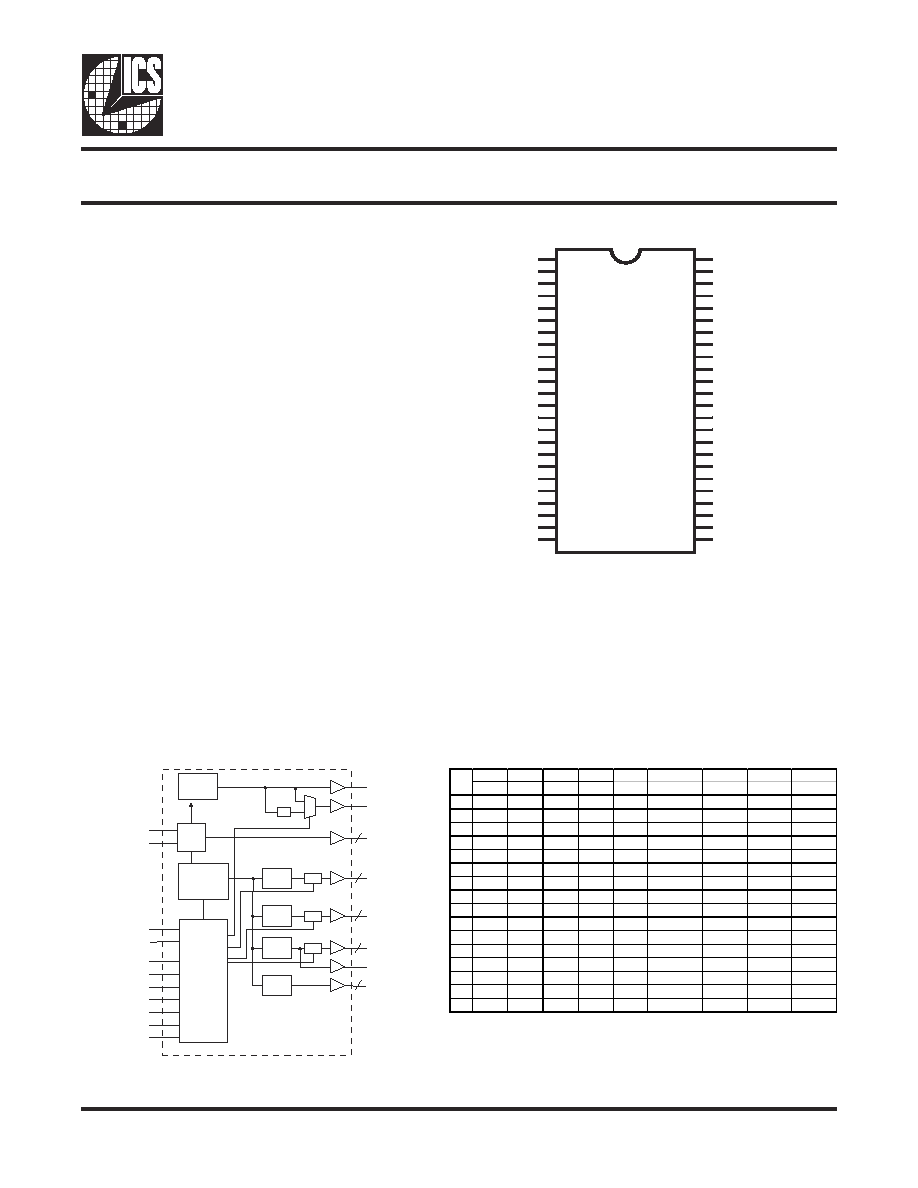
ICS951901
Integrated
Circuit
Systems, Inc.
0670B--07/15/04
Programmable Frequency Generator & Integrated Buffers for Pentium
III
Processor
Block Diagram
Recommended Application:
Single chip clock solution for IA platform.
Output Features:
·
3 - CPU @ 2.5V
·
13 - SDRAM @ 3.3V
·
6 - PCI @3.3V,
·
2 - AGP @ 3.3V
·
1 - 48MHz, @3.3V fixed.
·
1 - 24/48MHz, @3.3V selectable by I
2
C
(Default is 24MHz)
·
2 - REF @3.3V, 14.318MHz.
Features:
·
Programmable ouput frequency.
·
Programmable ouput rise/fall time.
·
Programmable SDRAM and CPU skew.
·
Spread spectrum for EMI control typically
by 7dB to 8dB,
with programmable spread percentage.
·
Watchdog timer technology to reset system
if over-clocking causes malfunction.
·
Uses external 14.318MHz crystal.
·
FS pins for frequency select
Skew Specifications:
·
CPU - CPU: < 175ps
·
SDRAM - SDRAM < 250ps (except SDRAM12)
·
PCI - PCI: < 500ps
·
CPU (early) - PCI: 1-4ns (typ. 2ns)
Functionality
Pin Configuration
48-Pin 300mil SSOP
* These inputs have a 120K pull down to GND.
1
These are double strength.
PLL2
PLL1
Spread
Spectrum
48MHz
24_48MHz
CPUCLK (2:0)
SDRAM (12:0)
PCICLK (4:0)
AGP (1:0)
PCICLK_F
2
5
13
3
2
X1
X2
XTAL
OSC
CPU
DIVDER
SDRAM
DIVDER
PCI
DIVDER
Stop
Stop
Stop
SDATA
SCLK
FS(3:0)
PD#
PCI_STOP#
CPU_STOP#
SDRAM_STOP#
MODE
AGP_SEL
Control
Logic
Config.
Reg.
/ 2
REF(1:0)
AGP
DIVDER
VDDA
(AGPSEL)REF0
*(FS3)REF1
GND
X1
X2
VDDPCI
*(FS1)PCICLK_F
*(FS2)PCICLK0
PCICLK1
PCICLK2
PCICLK3
PCICLK4
GND
VDDAGP
AGPCLK0
AGPCLK1
GND
GND
*(FS0)48MHz
*(MODE)24_48MHz
VDD48
SDATA
SCLK
1
1
*
VDDL
CPUCLK0
CPUCLK1
CPUCLK2
GND
VDDSDR
SDRAM0
SDRAM1
SDRAM2
GND
SDRAM3
SDRAM4
SDRAM5
VDDSDR
SDRAM6
SDRAM7
GND
SDRAM8/PD#
SDRAM9/SDRAM_STOP#
GND
SDRAM10/PCI_STOP#
SDRAM11/CPU_STOP#
SDRAM12
VDDSDR
ICS9519
01
1
2
3
4
5
6
7
8
9
10
11
12
13
14
15
16
17
18
19
20
21
22
23
24
48
47
46
45
44
43
42
41
40
39
38
37
36
35
34
33
32
31
30
29
28
27
26
25
FS3
FS2
FS1
FS0
CPU
SDRAM
PCI
AGP1
AGP0
Bit7
Bit6
Bit5
Bit4
MHz
MHz
MHz
SEL=1
SEL=0
0
0
0
0
0
66.67
66.67
33.33
66.67
64
0
0
0
0
1
66.67
100.00
33.33
66.67
64
0
0
0
1
0
66.67
133.34
33.33
66.67
64
0
0
0
1
1
75.00
75.00
37.50
75.00
64
0
0
1
0
0
83.31
83.31
33.32
66.64
64
0
0
1
0
1
90.00
90.00
30.00
60.00
64
0
0
1
1
0
95.00
95.00
31.67
63.33
64
0
0
1
1
1
100.00
66.67
33.33
66.67
64
0
1
0
0
0
100.00
100.00
33.33
66.67
64
0
1
0
0
1
100.00
133.34
33.33
66.67
64
0
1
0
1
0
105.00
105.00
35.00
70.00
64
0
1
0
1
1
112.00
112.00
33.60
67.20
64
0
1
1
0
0
117.99
117.99
35.40
70.80
64
0
1
1
0
1
124.09
124.09
31.02
62.05
64
0
1
1
1
0
133.34
100.00
33.33
66.67
64
0
1
1
1
1
133.34
133.34
33.33
66.67
64
Bit2

2
ICS951901
0670B--07/15/04
General Description
Pin Configuration
The ICS951901 is a single chip clock solution for desktop
designs using 630S chipsets. It provides all necessary
clock signals for such a system.
The ICS951901 belongs to ICS new generation of
programmable system clock generators. It employs serial
programming I
2
C interface as a vehicle for changing
output functions, changing output frequency, configuring
output strength, configuring output to output skew, changing
spread spectrum amount, changing group divider ratio and
dis/enabling individual clocks. This device also has ICS
propriety 'Watchdog Timer' technology which will reset the
frequency to a safe setting if the system becomes
unstable from over clocking.
Power Groups
Analog
VDDA = X1, X2, Core, PLL
VDD48 = 48MHz, 24MHz, fixed PLL
Digital
VDDPCI = PCICLK_F, PCICLK
VDDSDR = SDRAM
VDDAGP=AGP, REF
E
D
O
M
1
2
n
i
P
7
2
n
i
P
8
2
n
i
P
0
3
n
i
P
1
3
n
i
P
0
1
1
M
A
R
D
S
0
1
M
A
R
D
S
9
M
A
R
D
S
8
M
A
R
D
S
1
#
P
O
T
S
_
U
P
C
#
P
O
T
S
_
I
C
P
#
P
O
T
S
_
M
A
R
D
S
#
D
P
MODE Pin Power Management Control Input
PIN NUMBER
PIN NAME
TYPE
DESCRIPTION
1, 7, 15, 22, 25,
35, 43
VDD
PWR
3.3V Power supply for SDRAM output buffers, PCI output buffers,
reference output buffers and 48MHz output
AGPSEL
IN
AGP frequency select pin.
REF0
OUT
14.318 MHz reference clock.
FS3
IN
Frequency select pin.
REF1
OUT
14.318 MHz reference clock.
4, 14, 18, 19, 29,
32, 39, 44
GND
PWR
Ground pin for 3V outputs.
5
X1
IN
Crystal input,nominally 14.318MHz.
6
X2
OUT
Crystal output, nominally 14.318MHz.
FS1
IN
Frequency select pin.
PCICLK_F
OUT
PCI clock output, not affected by PCI_STOP#
FS2
IN
Frequency select pin.
PCICLK0
OUT
PCI clock output.
13, 12, 11, 10
PCICLK (4:1)
OUT
PCI clock outputs.
17, 16,
AGP (1:0)
OUT
AGP outputs defined as 2X PCI. These may not be stopped.
FS0
IN
Frequency select pin.
48MHz
OUT
48MHz output clock
MODE
IN
Pin 27, 28, 30, & 31 function select pin
0=Desktop 1=Mobile mode
24_48MHz
OUT
Clock output for super I/O/USB default is 24MHz
23
SDATA
I/O
Data pin for I
2
C circuitry 5V tolerant
24
SCLK
IN
Clock pin of I
2
C circuitry 5V tolerant
CPU_STOP#
IN
Stops all PCICLKs besides the PCICLK_F clocks at logic 0 level,
when input is low and MODE pin is in Mobile mode
SDRAM11
OUT
SDRAM clock output
PCI_STOP#
IN
Stops all CPUCLKs clocks at logic 0 level, when input is low and
MODE pin is in Mobile mode
SDRAM10
OUT
SDRAM clock output
SDRAM9
OUT
SDRAM clock output
SDRAM_STOP#
IN
Stops all SDRAM clocks at logic 0 level, when input is low and
MODE pin is in Mobile mode
PD#
IN
Asynchronous active low input pin used to power down the device
into a low power state. The internal clocks are disabled and the
VCO and the crystal are stopped. The latency of the power down will
not be greater than 3ms
SDRAM8
OUT
SDRAM clock output
26 33, 34, 36,
37, 38, 40, 41,
42
SDRAM (12,
7:0)
OUT
SDRAM clock outputs
45, 46, 47
CPUCLK (2:0)
OUT
CPU clock outputs.
48
VDDL
PWR
Power pin for the CPUCLKs. 2.5V
31
20
2
8
9
21
3
30
27
28
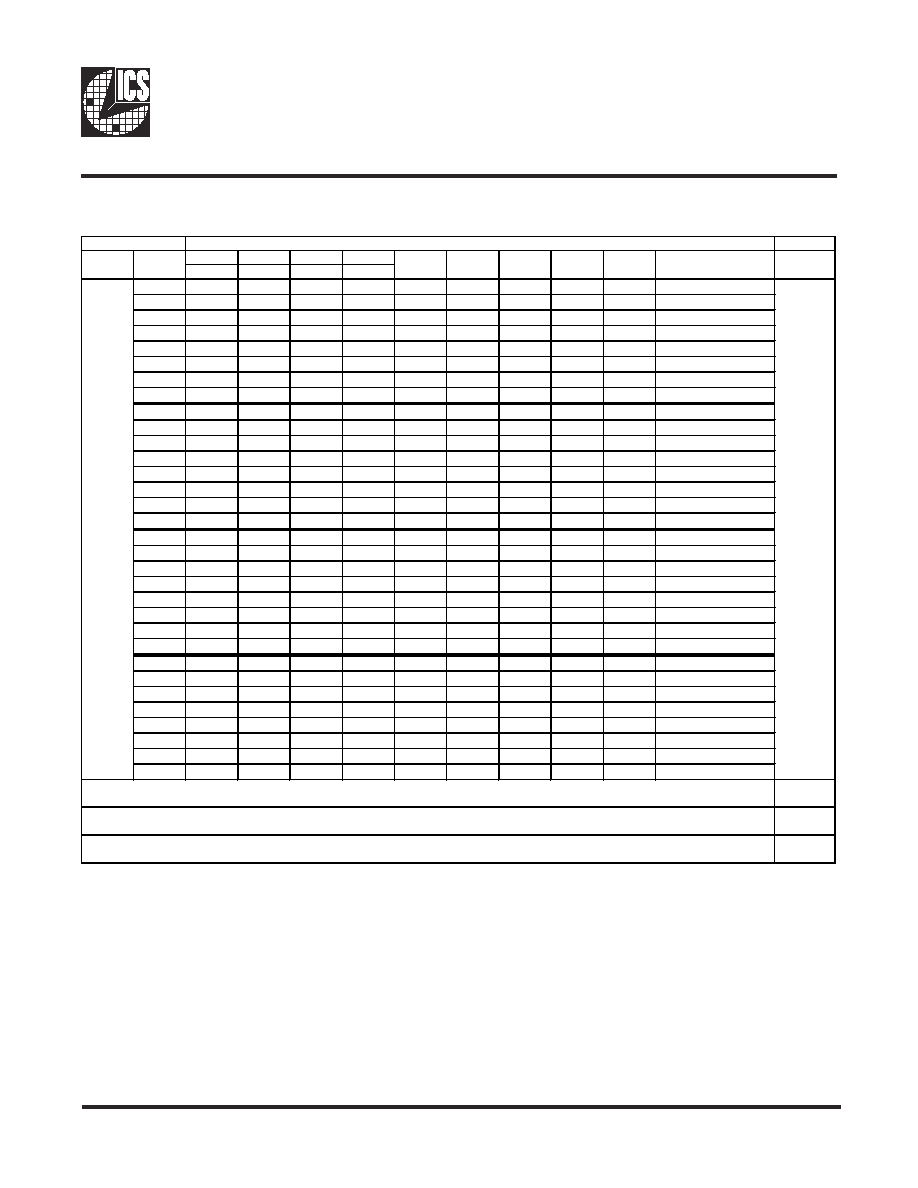
3
ICS951901
0670B--07/15/04
Byte0: Functionality and Frequency Select Register (default = 0)
Serial Configuration Command Bitmap
Note: PWD = Power-Up Default
Note1:
Default at power-up will be for latched logic inputs to define frequency, as displayed by Bit 3.
I
2
C is a trademark of Philips Corporation
FS3
FS2
FS1
FS0
CPU
SDRAM
PCI
AGP1
AGP0
Spread %
PWD
Bit2
Bit7
Bit6
Bit5
Bit4
MHz
MHz
MHz
SEL=1
SEL=0
0
0
0
0
0
66.67
66.67
33.33
66.67
64
± 0.35% center spread
0
0
0
0
1
66.67
100.00
33.33
66.67
64
± 0.35% center spread
0
0
0
1
0
66.67
133.34
33.33
66.67
64
± 0.35% center spread
0
0
0
1
1
75.00
75.00
37.50
75.00
64
± 0.35% center spread
0
0
1
0
0
83.31
83.31
33.32
66.64
64
± 0.35% center spread
0
0
1
0
1
90.00
90.00
30.00
60.00
64
± 0.35% center spread
0
0
1
1
0
95.00
95.00
31.67
63.33
64
± 0.35% center spread
0
0
1
1
1
100.00
66.67
33.33
66.67
64
± 0.35% center spread
0
1
0
0
0
100.00
100.00
33.33
66.67
64
± 0.35% center spread
0
1
0
0
1
100.00
133.34
33.33
66.67
64
± 0.35% center spread
0
1
0
1
0
105.00
105.00
35.00
70.00
64
± 0.35% center spread
0
1
0
1
1
112.00
112.00
33.60
67.20
64
± 0.35% center spread
0
1
1
0
0
117.99
117.99
35.40
70.80
64
± 0.35% center spread
0
1
1
0
1
124.09
124.09
31.02
62.05
64
± 0.35% center spread
Bit 2
0
1
1
1
0
133.34
100.00
33.33
66.67
64
± 0.35% center spread
00000
Bit 7:4
0
1
1
1
1
133.34
133.34
33.33
66.67
64
± 0.35% center spread
Note1
1
0
0
0
0
75.00
100.00
37.50
75.00
64
± 0.35% center spread
1
0
0
0
1
75.00
112.50
32.14
64.29
64
± 0.35% center spread
1
0
0
1
0
75.00
150.00
32.14
64.29
64
± 0.35% center spread
1
0
0
1
1
83.31
111.07
33.32
66.64
64
± 0.35% center spread
1
0
1
0
0
83.32
166.65
31.25
62.49
64
± 0.35% center spread
1
0
1
0
1
90.00
60.00
30.00
60.00
64
± 0.35% center spread
1
0
1
1
0
90.00
120.00
30.00
60.00
64
± 0.35% center spread
1
0
1
1
1
95.00
63.33
31.67
63.33
64
± 0.35% center spread
1
1
0
0
0
95.00
126.66
31.67
63.33
64
± 0.35% center spread
1
1
0
0
1
105.00
70.00
35.00
70.00
64
± 0.35% center spread
1
1
0
1
0
105.00
140.00
35.00
70.00
64
± 0.35% center spread
1
1
0
1
1
112.00
84.00
33.60
67.20
64
± 0.35% center spread
1
1
1
0
0
117.99
88.49
35.40
70.80
64
± 0.35% center spread
1
1
1
0
1
124.09
93.07
31.02
62.05
64
± 0.35% center spread
1
1
1
1
0
129.99
97.49
32.50
64.99
64
± 0.35% center spread
1
1
1
1
1
140.00
105.00
35.00
70.00
64
± 0.35% center spread
Bit 3
0 - Frequency is selected by hardware select, Latched inputs
0
1 - Frequency is selected by Bit, 2 7:4
Bit 1
0 - Normal
1
1 - Spread Spectrum Enabled
Bit 0
0 - Running
0
1 - Tristate all outputs
Bit
Description

4
ICS951901
0670B--07/15/04
Byte 1: CPU, Active/Inactive Register
(1= enable, 0 = disable)
Byte 2: PCI, Active/Inactive Register
(1= enable, 0 = disable)
T
I
B
#
N
I
P
D
W
P
N
O
I
T
P
I
R
C
S
E
D
7
t
i
B
-
1
d
e
v
r
e
s
e
R
6
t
i
B
-
1
d
e
v
r
e
s
e
R
5
t
i
B
3
1
1
4
K
L
C
I
C
P
4
t
i
B
2
1
1
3
K
L
C
I
C
P
3
t
i
B
1
1
1
2
K
L
C
I
C
P
2
t
i
B
0
1
1
1
K
L
C
I
C
P
1
t
i
B
9
1
0
K
L
C
I
C
P
0
t
i
B
8
1
F
_
K
L
C
I
C
P
Notes:
1. Inactive means outputs are held LOW and are disabled
from switching.
2. Latched Frequency Selects (FS#) will be inverted logic
load of the input frequency select pin conditions.
T
I
B
#
N
I
P
D
W
P
N
O
I
T
P
I
R
C
S
E
D
7
t
i
B
-
1
d
e
v
r
e
s
e
R
6
t
i
B
1
2
1
z
H
M
8
4
_
4
2
5
t
i
B
0
2
1
z
H
M
8
4
4
t
i
B
6
2
1
2
1
M
A
R
D
S
3
t
i
B
7
2
1
1
1
M
A
R
D
S
2
t
i
B
8
2
1
0
1
M
A
R
D
S
1
t
i
B
0
3
1
9
M
A
R
D
S
0
t
i
B
1
3
1
8
M
A
R
D
S
Byte 4: SDRAM , Active/Inactive Register
(1= enable, 0 = disable)
T
I
B
#
N
I
P
D
W
P
N
O
I
T
P
I
R
C
S
E
D
7
t
i
B
-
X
)
k
c
a
b
d
a
e
R
(
3
S
F
6
t
i
B
-
X
)
k
c
a
b
d
a
e
R
(
2
S
F
5
t
i
B
-
X
)
k
c
a
b
d
a
e
R
(
1
S
F
4
t
i
B
-
X
)
k
c
a
b
d
a
e
R
(
0
S
F
3
t
i
B
3
1
0
F
E
R
2
t
i
B
2
1
1
F
E
R
1
t
i
B
7
1
1
1
K
L
C
P
G
A
0
t
i
B
6
1
1
0
K
L
C
P
G
A
Byte 5: AGP, Active/Inactive Register
(1= enable, 0 = disable)
Byte 3: SDRAM, Active/Inactive Register
(1= enable, 0 = disable)
T
I
B
#
N
I
P
D
W
P
N
O
I
T
P
I
R
C
S
E
D
7
t
i
B
3
3
1
7
M
A
R
D
S
6
t
i
B
4
3
1
6
M
A
R
D
S
5
t
i
B
6
3
1
5
M
A
R
D
S
4
t
i
B
7
3
1
4
M
A
R
D
S
3
t
i
B
8
3
1
3
M
A
R
D
S
2
t
i
B
0
4
1
2
M
A
R
D
S
1
t
i
B
1
4
1
1
M
A
R
D
S
0
t
i
B
2
4
1
0
M
A
R
D
S
T
I
B
#
N
I
P
D
W
P
N
O
I
T
P
I
R
C
S
E
D
7
t
i
B
-
1
8
4
_
4
2
l
e
S
)
z
H
M
8
4
:
0
,
z
H
M
4
2
:
1
(
6
t
i
B
-
1
d
e
v
r
e
s
e
R
5
t
i
B
-
1
d
e
v
r
e
s
e
R
4
t
i
B
-
1
d
e
v
r
e
s
e
R
3
t
i
B
7
4
1
0
K
L
C
U
P
C
2
t
i
B
6
4
1
1
K
L
C
U
P
C
1
t
i
B
5
4
1
2
K
L
C
U
P
C
0
t
i
B
-
1
d
e
v
r
e
s
e
R

5
ICS951901
0670B--07/15/04
Byte 6: Control , Active/Inactive Register
(1= enable, 0 = disable)
T
I
B
#
N
I
P
D
W
P
N
O
I
T
P
I
R
C
S
E
D
7
t
i
B
-
0
d
e
v
r
e
s
e
R
6
t
i
B
-
0
d
e
v
r
e
s
e
R
5
t
i
B
-
1
d
e
v
r
e
s
e
R
4
t
i
B
-
0
d
e
v
r
e
s
e
R
3
t
i
B
-
1
d
e
v
r
e
s
e
R
2
t
i
B
-
0
d
e
v
r
e
s
e
R
1
t
i
B
-
0
d
e
v
r
e
s
e
R
0
t
i
B
-
1
d
e
v
r
e
s
e
R
Byte 7: Vendor ID Register
(1= enable, 0 = disable)
T
I
B
#
N
I
P
D
W
P
N
O
I
T
P
I
R
C
S
E
D
7
t
i
B
3
,
2
0
X
2
=
1
,
X
1
=
0
h
t
g
n
e
r
t
s
F
E
R
6
t
i
B
5
4
0
l
o
r
t
n
o
C
-
p
o
t
S
-
2
K
L
C
U
P
C
,
2
K
L
C
U
P
C
l
o
r
t
n
o
c
l
l
i
w
#
P
O
T
S
_
U
P
C
=
0
w
o
l
s
i
#
P
O
T
S
_
U
P
C
f
i
n
e
v
e
g
n
i
n
n
u
r
e
e
r
f
s
i
2
K
L
C
U
P
C
=
1
5
t
i
B
-
X
)
k
c
a
b
d
a
e
R
(
L
E
S
P
G
A
4
t
i
B
-
X
)
k
c
a
b
d
a
e
R
(
E
D
O
M
3
t
i
B
-
X
)
k
c
a
b
d
a
e
R
(
#
P
O
T
S
_
U
P
C
2
t
i
B
-
X
)
k
c
a
b
d
a
e
R
(
#
P
O
T
S
_
I
C
P
1
t
i
B
-
X
)
k
c
a
b
d
a
e
R
(
#
P
O
T
S
_
M
A
R
D
S
0
t
i
B
-
0
e
l
g
g
o
T
d
e
e
p
S
P
G
A
,
g
n
i
t
t
e
s
t
u
p
n
i
h
c
t
a
l
y
b
d
e
n
i
m
r
e
t
e
d
e
b
l
l
i
w
)
2
n
i
p
(
L
E
S
P
G
A
=
0
g
n
i
t
t
e
s
t
u
p
n
i
h
c
t
a
l
f
o
e
t
i
s
o
p
p
o
e
b
l
l
i
w
L
E
S
P
G
A
=
1
Byte 8: Byte Count and Read Back Register
(1= enable, 0 = disable)
T
I
B
#
N
I
P
D
W
P
N
O
I
T
P
I
R
C
S
E
D
7
t
i
B
-
0
d
e
v
r
e
s
e
R
6
t
i
B
-
0
d
e
v
r
e
s
e
R
5
t
i
B
-
0
d
e
v
r
e
s
e
R
4
t
i
B
-
0
d
e
v
r
e
s
e
R
3
t
i
B
-
0
d
e
v
r
e
s
e
R
2
t
i
B
-
1
d
e
v
r
e
s
e
R
1
t
i
B
-
0
d
e
v
r
e
s
e
R
0
t
i
B
-
0
d
e
v
r
e
s
e
R
Note: FS values in bit [0:4] will correspond to Byte 0 FS
values. Default safe frequency is same as 00000
entry in byte0.
Byte 10: VCO Control Selection Bit &
Watchdog Timer Control Register
t
i
B
D
W
P
n
o
i
t
p
i
r
c
s
e
D
7
t
i
B
0
q
e
r
f
2
1
&
1
1
B
=
1
/
q
e
r
f
0
B
/
w
H
=
0
6
t
i
B
0
e
l
b
a
n
e
=
1
/
e
l
b
a
s
i
d
=
0
e
l
b
a
n
E
D
W
5
t
i
B
0
m
r
a
l
a
=
1
/
l
a
m
r
o
n
=
0
s
u
t
a
t
S
D
W
4
t
i
B
0
2
t
i
b
0
e
t
y
B
,
y
c
n
e
u
q
e
r
F
e
f
a
S
D
W
3
t
i
B
0
3
S
F
,
y
c
n
e
u
q
e
r
F
e
f
a
S
D
W
2
t
i
B
0
2
S
F
,
y
c
n
e
u
q
e
r
F
e
f
a
S
D
W
1
t
i
B
0
1
S
F
,
y
c
n
e
u
q
e
r
F
e
f
a
S
D
W
0
t
i
B
0
0
S
F
,
y
c
n
e
u
q
e
r
F
e
f
a
S
D
W
Byte 9: Watchdog Timer Count Register
ti
B
D
W
P
n
o
it
p
i
r
c
s
e
D
7
ti
B
0
e
s
e
h
t
f
o
n
o
it
a
t
n
e
s
e
r
p
e
r
l
a
m
i
c
e
d
e
h
T
s
m
1
r
o
s
m
0
9
2
o
t
d
n
o
p
s
e
r
r
o
c
s
ti
b
8
e
r
o
f
e
b
ti
a
w
ll
i
w
r
e
m
it
g
o
d
h
c
t
a
w
e
h
t
e
h
t
t
e
s
e
r
d
n
a
e
d
o
m
m
r
a
l
a
o
t
s
e
o
g
ti
tl
u
a
f
e
D
.
g
n
it
t
e
s
e
f
a
s
e
h
t
o
t
y
c
n
e
u
q
e
r
f
6
.
4
=
s
m
0
9
2
X
6
1
s
i
p
u
r
e
w
o
p
t
a
.
s
d
n
o
c
e
s
6
ti
B
0
5
ti
B
0
4
ti
B
1
3
ti
B
0
2
ti
B
0
1
ti
B
0
0
ti
B
0

6
ICS951901
0670B--07/15/04
Notes:
1. PWD = Power on Default
Byte 11: VCO Frequency Control Register
Note: The decimal representation of these 7 bits (Byte 11
[6:0]) + 2 is equal to the REF divider value .
t
i
B
D
W
P
n
o
i
t
p
i
r
c
s
e
D
7
t
i
B
X
0
t
i
B
r
e
d
i
v
i
D
O
C
V
6
t
i
B
X
6
t
i
B
r
e
d
i
v
i
D
F
E
R
5
t
i
B
X
5
t
i
B
r
e
d
i
v
i
D
F
E
R
4
t
i
B
X
4
t
i
B
r
e
d
i
v
i
D
F
E
R
3
t
i
B
X
3
t
i
B
r
e
d
i
v
i
D
F
E
R
2
t
i
B
X
2
t
i
B
r
e
d
i
v
i
D
F
E
R
1
t
i
B
X
1
t
i
B
r
e
d
i
v
i
D
F
E
R
0
t
i
B
X
0
t
i
B
r
e
d
i
v
i
D
F
E
R
Byte 12: VCO Frequency Control Register
Note: The decimal representation of these 9 bits (Byte
12 bit [7:0] & Byte 11 bit [7] ) + 8 is equal to the VCO
divider value. For example if VCO divider value of 36
is desired, user need to program 36 - 8 = 28, namely, 0,
00011100 into byte 12 bit & byte 11 bit 7.
t
i
B
D
W
P
n
o
i
t
p
i
r
c
s
e
D
7
t
i
B
X
8
t
i
B
r
e
d
i
v
i
D
O
C
V
6
t
i
B
X
7
t
i
B
r
e
d
i
v
i
D
O
C
V
5
t
i
B
X
6
t
i
B
r
e
d
i
v
i
D
O
C
V
4
t
i
B
X
5
t
i
B
r
e
d
i
v
i
D
O
C
V
3
t
i
B
X
4
t
i
B
r
e
d
i
v
i
D
O
C
V
2
t
i
B
X
3
t
i
B
r
e
d
i
v
i
D
O
C
V
1
t
i
B
X
2
t
i
B
r
e
d
i
v
i
D
O
C
V
0
t
i
B
X
1
t
i
B
r
e
d
i
v
i
D
O
C
V
Byte 13: Spread Sectrum Control Register
Byte 14: Spread Sectrum Control Register
Note: Please utilize software utility provided by ICS
Application Engineering to configure spread
spectrum. Incorrect spread percentage may cause
system failure.
ti
B
D
W
P
n
o
it
p
i
r
c
s
e
D
7
ti
B
X
7
ti
B
m
u
r
t
c
e
p
S
d
a
e
r
p
S
6
ti
B
X
6
ti
B
m
u
r
t
c
e
p
S
d
a
e
r
p
S
5
ti
B
X
5
ti
B
m
u
r
t
c
e
p
S
d
a
e
r
p
S
4
ti
B
X
4
ti
B
m
u
r
t
c
e
p
S
d
a
e
r
p
S
3
ti
B
X
3
ti
B
m
u
r
t
c
e
p
S
d
a
e
r
p
S
2
ti
B
X
2
ti
B
m
u
r
t
c
e
p
S
d
a
e
r
p
S
1
ti
B
X
1
ti
B
m
u
r
t
c
e
p
S
d
a
e
r
p
S
0
ti
B
X
0
ti
B
m
u
r
t
c
e
p
S
d
a
e
r
p
S
t
i
B
D
W
P
n
o
i
t
p
i
r
c
s
e
D
7
t
i
B
X
d
e
v
r
e
s
e
R
6
t
i
B
X
d
e
v
r
e
s
e
R
5
t
i
B
X
d
e
v
r
e
s
e
R
4
t
i
B
X
2
1
t
i
B
m
u
r
t
c
e
p
S
d
a
e
r
p
S
3
t
i
B
X
1
1
t
i
B
m
u
r
t
c
e
p
S
d
a
e
r
p
S
2
t
i
B
X
0
1
t
i
B
m
u
r
t
c
e
p
S
d
a
e
r
p
S
1
t
i
B
X
9
i
B
m
u
r
t
c
e
p
S
d
a
e
r
p
S
0
t
i
B
X
8
t
i
B
m
u
r
t
c
e
p
S
d
a
e
r
p
S
Note: Please utilize software utility provided by ICS
Application Engineering to configure spread
spectrum. Incorrect spread percentage may cause
system failure.
Byte 15: Output Skew Control
Byte 16: Output Skew Control
t
i
B
D
W
P
n
o
i
t
p
i
r
c
s
e
D
7
t
i
B
1
l
o
r
t
n
o
C
w
e
k
S
2
1
M
A
R
D
S
6
t
i
B
0
5
t
i
B
0
l
o
r
t
n
o
C
w
e
k
S
)
0
:
1
1
(
M
A
R
D
S
4
t
i
B
1
3
t
i
B
1
l
o
r
t
n
o
C
w
e
k
S
2
K
L
C
U
P
C
2
t
i
B
1
1
t
i
B
1
l
o
r
t
n
o
C
w
e
k
S
)
0
:
1
(
K
L
C
U
P
C
0
t
i
B
0
t
i
B
D
W
P
n
o
i
t
p
i
r
c
s
e
D
7
t
i
B
X
d
e
v
r
e
s
e
R
6
t
i
B
X
d
e
v
r
e
s
e
R
5
t
i
B
X
d
e
v
r
e
s
e
R
4
t
i
B
X
d
e
v
r
e
s
e
R
3
t
i
B
X
d
e
v
r
e
s
e
R
2
t
i
B
X
d
e
v
r
e
s
e
R
1
t
i
B
X
d
e
v
r
e
s
e
R
0
t
i
B
X
d
e
v
r
e
s
e
R
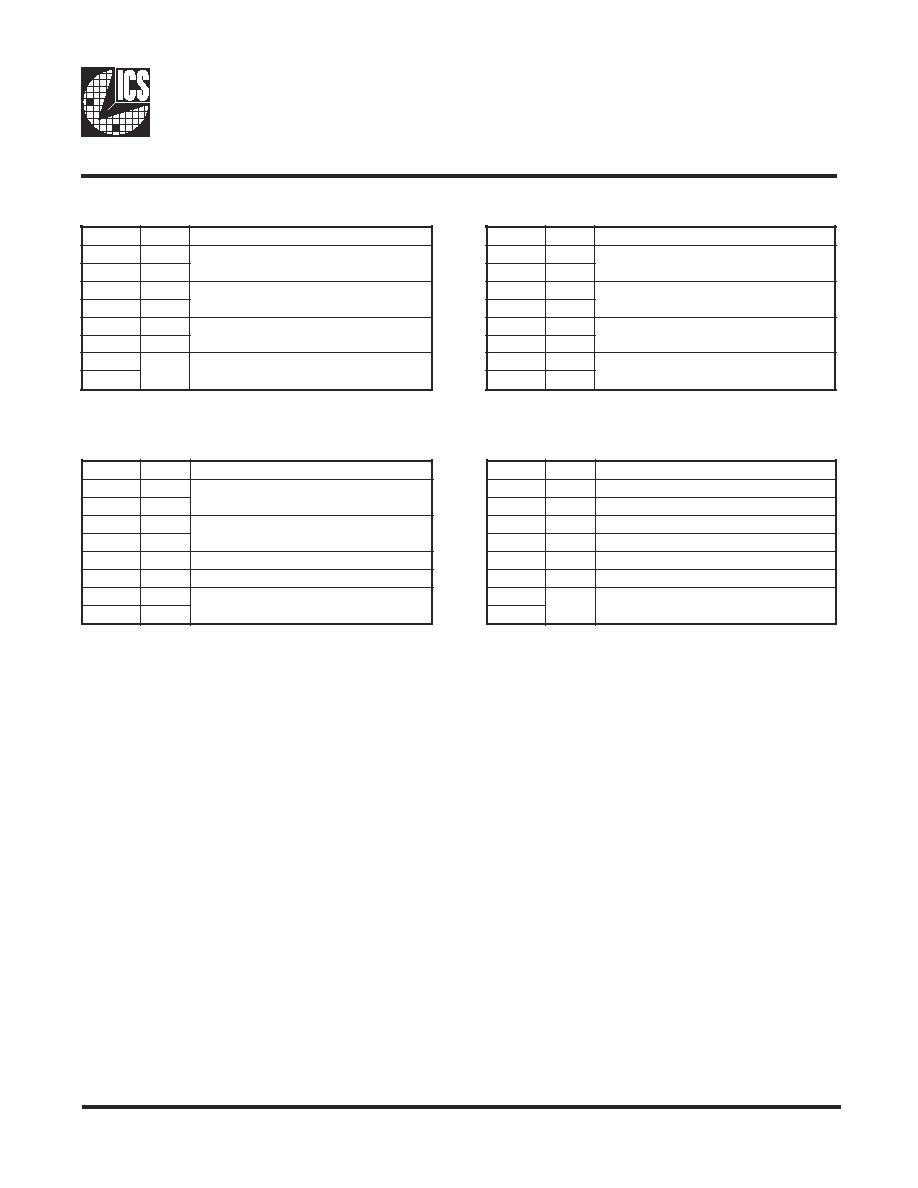
7
ICS951901
0670B--07/15/04
Byte 17: Output Rise/Fall Time Select Register
Byte 18: Output Rise/Fall Time Select Register
t
i
B
D
W
P
n
o
i
t
p
i
r
c
s
e
D
7
t
i
B
1
l
o
r
t
n
o
C
e
t
a
R
w
e
l
S
)
0
:
3
(
I
C
P
6
t
i
B
0
5
t
i
B
1
l
o
r
t
n
o
C
e
t
a
R
w
e
l
S
F
_
I
C
P
4
t
i
B
0
3
t
i
B
1
l
o
r
t
n
o
C
e
t
a
R
w
e
l
S
2
K
L
C
U
P
C
2
t
i
B
0
1
t
i
B
0
l
o
r
t
n
o
C
e
t
a
r
w
e
l
S
1
K
L
C
U
P
C
0
t
i
B
t
i
B
D
W
P
n
o
i
t
p
i
r
c
s
e
D
7
t
i
B
1
l
o
r
t
n
o
C
e
t
a
R
w
e
l
S
:
2
1
M
A
R
D
S
6
t
i
B
0
5
t
i
B
1
l
o
r
t
n
o
C
e
t
a
R
w
e
l
S
:
1
K
L
C
P
G
A
4
t
i
B
0
3
t
i
B
1
l
o
r
t
n
o
C
e
t
a
R
w
e
l
S
:
0
K
L
C
P
G
A
2
t
i
B
0
1
t
i
B
1
l
o
r
t
n
o
C
e
t
a
R
w
e
l
S
:
4
K
L
C
I
C
P
0
t
i
B
0
Byte 19: Output Rise/Fall Time Select Register
Byte 20: Output Rise/Fall Time Select Register
ti
B
D
W
P
n
o
it
p
i
r
c
s
e
D
7
ti
B
1
l
o
r
t
n
o
C
e
t
a
R
w
e
l
S
:
z
H
M
8
4
6
ti
B
0
5
ti
B
1
l
o
r
t
n
o
C
e
t
a
R
w
e
l
S
:
z
H
M
8
4
_
4
2
4
ti
B
0
3
ti
B
1
l
o
r
t
n
o
C
e
t
a
R
w
e
l
S
:
1
F
E
R
2
ti
B
0
l
o
r
t
n
o
C
e
t
a
R
w
e
l
S
:
0
F
E
R
1
ti
B
1
l
o
r
t
n
o
C
e
t
a
R
w
e
l
S
:
)
0
:
1
1
(
M
A
R
D
S
0
ti
B
0
t
i
B
D
W
P
n
o
i
t
p
i
r
c
s
e
D
7
t
i
B
0
d
e
v
r
e
s
e
R
6
t
i
B
0
d
e
v
r
e
s
e
R
5
t
i
B
0
d
e
v
r
e
s
e
R
4
t
i
B
0
d
e
v
r
e
s
e
R
3
t
i
B
0
d
e
v
r
e
s
e
R
2
t
i
B
0
d
e
v
r
e
s
e
R
1
t
i
B
0
l
o
r
t
n
o
C
e
t
a
R
w
e
l
S
0
K
L
C
U
P
C
0
t
i
B
VCO Programming Constrains
VCO Frequency ...................... 150MHz to 500MHz
VCO Divider Range ................ 8 to 519
REF Divider Range ................. 2 to 129
Phase Detector Stability .......... 0.3536 to 1.4142
Useful Formula
VCO Frequency = 14.31818 x VCO/REF divider value
Phase Detector Stabiliy = 14.038 x (VCO divider value)
-0.5
To program the VCO frequency for over-clocking.
0. Before trying to program our clock manually, consider using ICS provided software utilities for easy
programming.
1. Select the frequency you want to over-clock from with the desire gear ratio (i.e. CPU:SDRAM:3V66:PCI ratio) by
writing to byte 0, or using initial hardware power up frequency.
2. Write 0001, 1001 (19
H
) to byte 8 for readback of 21 bytes (byte 0-20).
3. Read back byte 11-20 and copy values in these registers.
4. Re-initialize the write sequence.
5. Write a '1' to byte 9 bit 7 and write to byte 11 & 12 with the desired VCO & REF divider values.
6. Write to byte 13 to 20 with the values you copy from step 3. This maintains the output spread, skew and slew
rate.
7. The above procedure is only needed when changing the VCO for the 1st pass. If VCO frequency needed to be
changed again, user only needs to write to byte 11 and 12 unless the system is to reboot.

8
ICS951901
0670B--07/15/04
Absolute Maximum Ratings
Supply Voltage . . . . . . . . . . . . . . . . . . . . . . . . . 5.5 V
Logic Inputs . . . . . . . . . . . . . . . . . . . . . . . . . . . GND 0.5 V to V
DD
+0.5 V
Ambient Operating Temperature . . . . . . . . . . 0°C to +70°C
Case Temperature . . . . . . . . . . . . . . . . . . . . . . 115°C
Storage Temperature . . . . . . . . . . . . . . . . . . . . 65°C to +150°C
Stresses above those listed under
Absolute Maximum Ratings may cause permanent damage to the device. These
ratings are stress specifications only and functional operation of the device at these or any other conditions above those
listed in the operational sections of the specifications is not implied. Exposure to absolute maximum rating conditions
for extended periods may affect product reliability.
Electrical Characteristics - Input/Supply/Common Output Parameters
TA = 0 - 70°C; Supply Volt age VDD = 3.3 V +/-5%VDDL = 2.5 V +/-5% (unless otherwise stated)
PARAMETER
SYMBOL
CONDITIONS
MIN
TYP
MAX
UNITS
Input High Voltage
V
IH
2
V
DD
+ 0.3
V
Input Low Voltage
V
IL
V
SS
- 0.3
0.8
V
Supply Current
I
DD
C
L
=30 pF, CPU @ 66, 100 MHz
390
400
mA
Power Down
PD
300
600
mA
Input frequency
Fi
V
DD
= 3.3 V;
12
14.32
16
MHz
Input Capacitance
1
C
IN
Logic Inputs
5
pF
C
INX
X1 & X2 pins
27
45
pF
Transition Time
T
trans
To 1st crossing of target Freq.
3
Settling Time
T
S
From 1st crossing to 1% target Freq.
Clk Stabilization
1
T
STAB
From V
DD
= 3.3 V to 1% target Freq.
3
ms
Skew
T
CPU-PCI
CPUV
T
= 1.5 V PCI V
T
=1.25V
1
1.9
4
ns
Skew
T
CPU-SDRAM
CPUV
T
= 1.5 V SDRAM V
T
=1.25
-500
-300
0
ps
1
Guaranteed by design, not 100% tested in production.
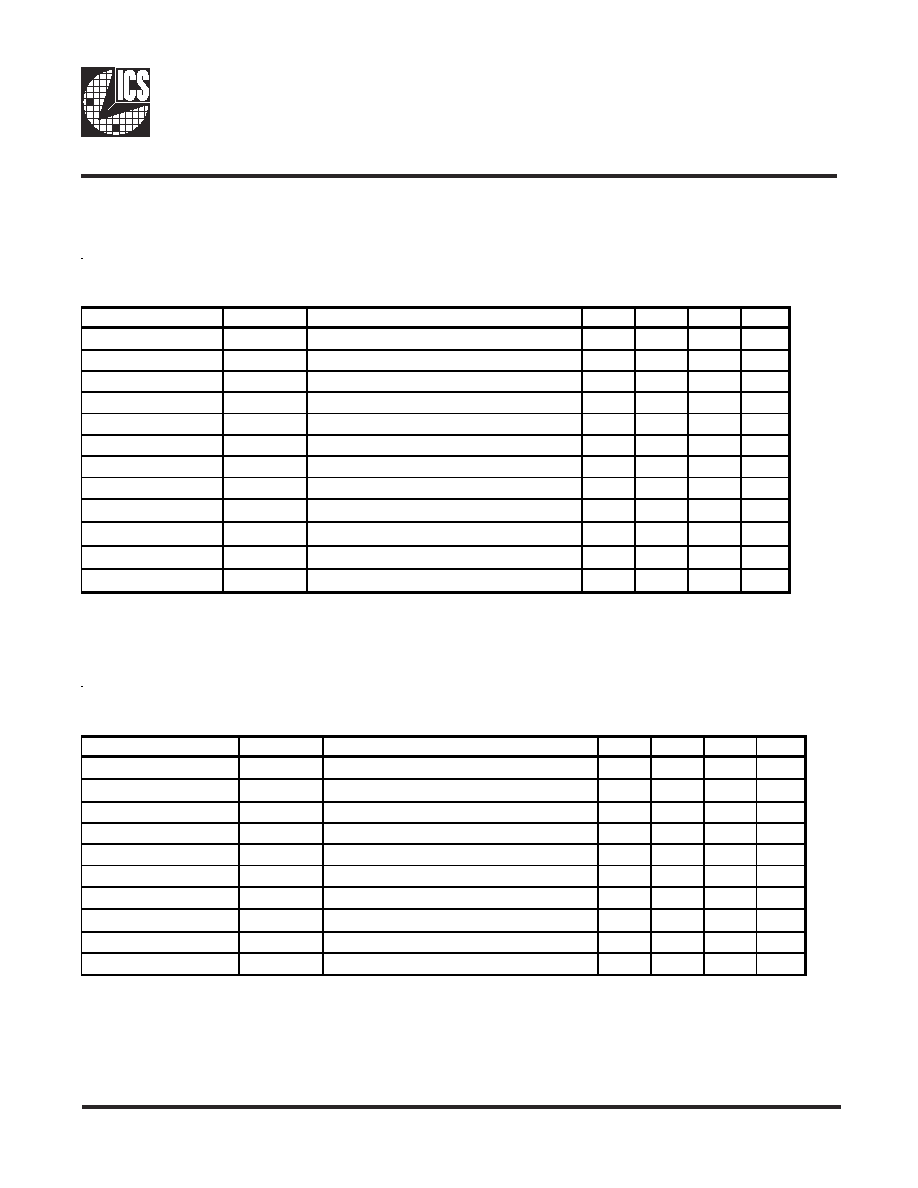
9
ICS951901
0670B--07/15/04
Electrical Characteristics - CPU
T
A
= 0 - 70°C; V
DDL
= 2.5 V +/-5%; VDDL = 2.5 V +/-5%; C
L
= 10-20 pF (unless otherwise specified)
PARAMETER
SYMBOL
CONDITIONS
MIN
TYP
MAX UNITS
Output Impedance
1
R
DSP2B
V
O
= V
DD
*(0.5)
10
20
Output Impedance
1
R
DSN2B
V
O
= V
DD
*(0.5)
10
20
Output High Voltage
V
OH2B
I
OH
= -12.0 mA
2
V
Output Low Voltage
V
OL2B
I
OL
= 12 mA
0.4
V
Output High Current
I
OH2B
V
OH
= 1.7 V
-19
mA
Output Low Current
I
OL2B
V
OL
= 0.7 V
19
mA
Rise Time
1
t
r2B
V
OL
= 0.4 V, V
OH
= 2.0 V
0.4
1.2
1.6
ns
Fall Time
1
t
f2B
V
OH
= 2.0 V, V
OL
= 0.4 V
0.4
1.1
1.6
ns
Duty Cycle
1
d
t2B
V
T
= 1.25 V
45
46.9
55
%
Skew window
0:1
t
sk2B
V
T
= 1.25 V
43
175
ps
Skew window
0:2
t
sk2B
V
T
= 1.25 V
142
375
ps
Jitter, Cycle-to-cycle
1
t
jcyc-cyc
V
T
= 1.25 V, CPU=66 MHz
177
250
ps
1
Guaranteed by design, not 100% tested in production.
Electrical Characteristics - 24-48MHz
T
A
= 0 - 70°C; V
DD
= 3.3 V +/-5%;VDDL = 2.5 V +/-5%; C
L
= 10-20 pF (unless otherwise specified)
PARAMETER
SYMBOL
CONDITIONS
MIN
TYP
MAX UNITS
Output Impedance
R
DSP5B
1
V
O
= V
DD
*(0.5)
20
60
Output Impedance
R
DSN5B
1
V
O
= V
DD
*(0.5)
20
60
Output High Voltage
V
OH15
I
OH
= -14 mA
2.4
V
Output Low Voltage
V
OL5
I
OL
= 6.0 mA
0.4
V
Output High Current
I
OH5
V
OH
= 2.0 V
-20
mA
Output Low Current
I
OL5
V
OL
= 0.8 V
10
mA
Rise Time
1
t
r5
V
OL
= 0.4 V, V
OH
= 2.4 V
0.4
1.45
4
ns
Fall Time
1
t
f5
V
OH
= 2.4 V, V
OL
= 0.4 V
0.4
1.5
4
ns
Duty Cycle
1
d
t5
V
T
= 1.5 V
45
52.5
55
%
Jitter
t
cycle to cycle
V
T
= 1.5 V
210
500
ps
1
Guaranteed by design, not 100% tested in production.
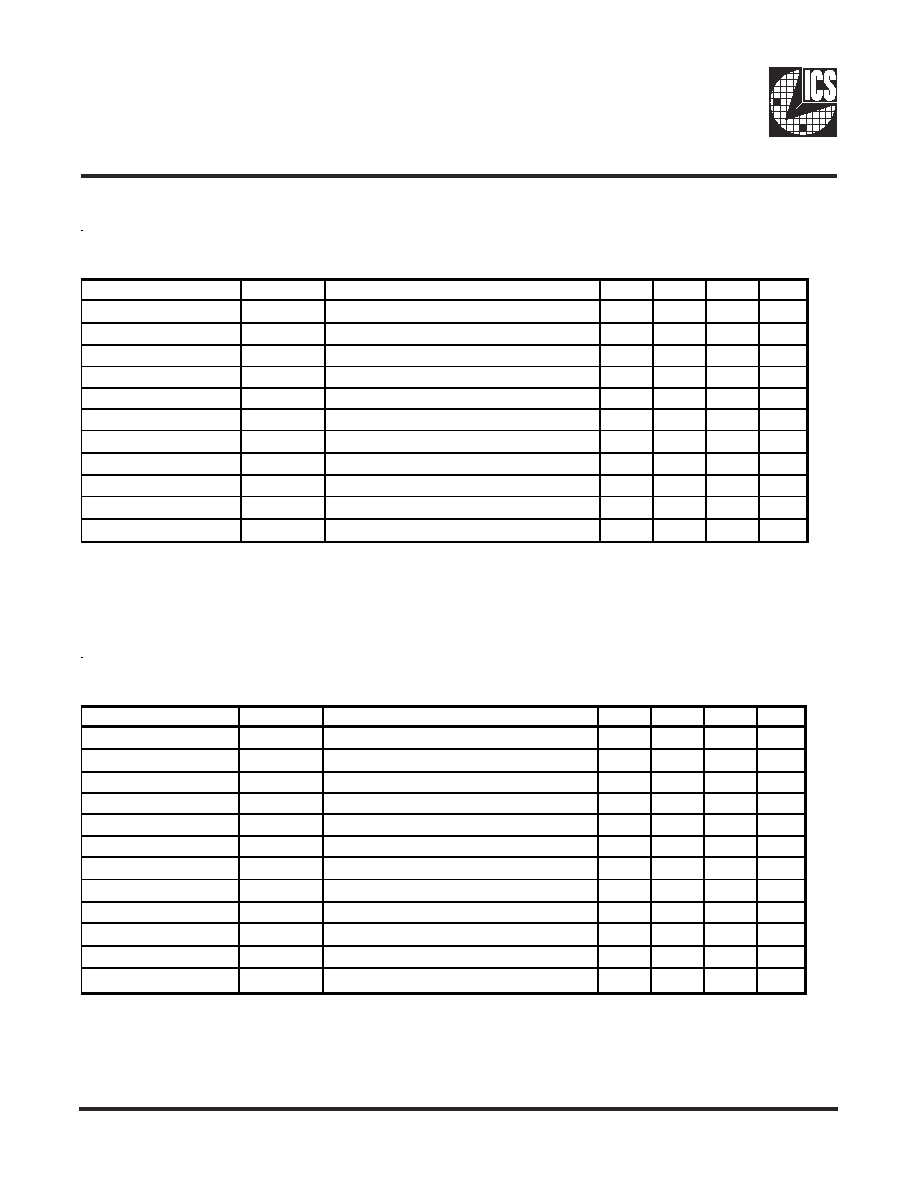
10
ICS951901
0670B--07/15/04
Electrical Characteristics - PCI
T
A
= 0 - 70°C; V
DD
= 3.3 V +/-5%; VDDL = 2.5 V +/-5%; C
L
= 10-30 pF (unless otherwise specified)
PARAMETER
SYMBOL
CONDITIONS
MIN
TYP
MAX UNITS
Output Impedance
R
DSP1B
1
V
O
= V
DD
*(0.5)
12
55
Output Impedance
R
DSN1B
1
V
O
= V
DD
*(0.5)
12
55
Output High Voltage
V
OH1
I
OH
= -1 mA
2.4
V
Output Low Voltage
V
OL1
I
OL
= 1 mA
0.55
V
Output High Current
I
OH1
V
OH @ MIN
= 1.0 V
-29
mA
Output Low Current
I
OL1
V
OL @ MIN
= 1.95 V
29
mA
Rise Time
1
t
r1
V
OL
= 0.4 V, V
OH
= 2.4 V
0.5
2.3
2.5
ns
Fall Time
1
t
f1
V
OH
= 2.4 V, V
OL
= 0.4 V
0.5
2.3
2.5
ns
Duty Cycle
1
d
t1
V
T
= 1.5 V
45
51.2
55
%
Skew window
1
t
sk1
V
T
= 1.5 V
108
500
ps
Jitter, Cycle-to-cycle
1
t
jcyc-cyc1
V
T
= 1.5 V
353
500
ps
1
Guaranteed by design, not 100% tested in production.
Electrical Characteristics - SDRAM
T
A
= 0 - 70°C; V
DD
= 3.3 V +/-5%;VDDL = 2.5 V +/-5%; C
L
= 20-30 pF (unless otherwise specified)
PARAMETER
SYMBOL
CONDITIONS
MIN
TYP
MAX UNITS
Output Impedance
R
DSP3B
1
V
O
= V
DD
*(0.5)
10
24
Output Impedance
R
DSN3B
1
V
O
= V
DD
*(0.5)
10
24
Output High Voltage
V
OH3
I
OH
= -18 mA
2.4
V
Output Low Voltage
V
OL3
I
OL
= 9.4 mA
0.4
V
Output High Current
I
OH3
V
OH
= 2.0 V
-46
mA
Output Low Current
I
OL3
V
OL
= 0.8V
mA
Rise Time
1
t
r3
V
OL
= 0.4 V, V
OH
= 2.4 V
0.8
1.6
ns
Fall Time
1
t
f3
V
OH
= 2.4 V, V
OL
= 0.4 V
0.8
1.6
ns
Duty Cycle
1
d
t3
V
T
= 1.5 V
45
48.5
55
%
Skew window
1(0:11)
t
sk3
V
T
= 1.5 V
192
250
ps
Skew window
1( 0:12)
t
sk3
V
T
= 1.5 V
290
500
ps
Jitter, Cycle-to-cycle
1
t
jcyc-cyc3
V
T
= 1.5 V, CPU=66,100,133 MHz
173
250
ps
1
Guaranteed by design, not 100% tested in production.
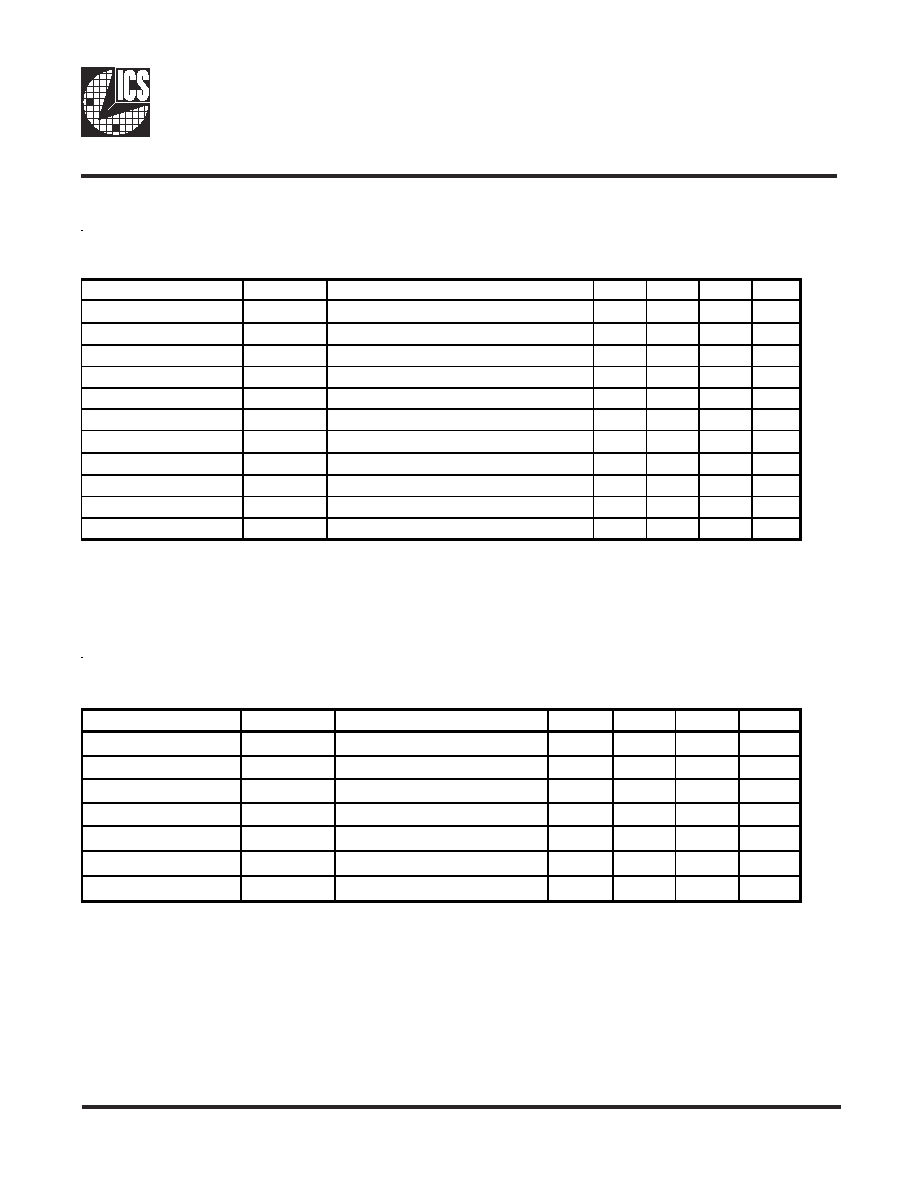
11
ICS951901
0670B--07/15/04
Electrical Characteristics - AGP
T
A
= 0 - 70°C; V
DD
=3.3V +/-5%; C
L
= 20 pF (unless otherwise specified)
PARAMETER
SYMBOL
CONDITIONS
MIN
TYP
MAX UNITS
Output Impedance
R
DSP4B
1
V
O
=V
DD
*(0.5)
12
55
Output Impedance
R
DSN4B
1
V
O
=V
DD
*(0.5)
12
55
Output High Voltage
V
OH4B
I
OH
= -18 mA
2
V
Output Low Voltage
V
OL4B
I
OL
= 18 mA
0.4
V
Output High Current
I
OH4B
V
OH
= 2.0 V
-19
mA
Output Low Current
I
OL4B
V
OL
= 0.8 V
19
mA
Rise Time
1
t
r4B
V
OL
= 0.4 V, V
OH
= 2.4 V
0.5
1.5
2
ns
Fall Time
1
t
f4B
V
OH
= 2.4 V, V
OL
= 0.4 V
0.5
1.6
2
ns
Duty Cycle
1
d
t4B
V
T
= 1.5 V
45
52.3
55
%
Skew window1
tsk
1
V
T
= 1.5 V
55.5
175
ps
Jitter Cyc-Cyc
tjcyc-cyc
1
V
T
= 1.5 V
239
500
ps
1
Guaranteed by design, not 100% tested in production.
Electrical Characteristics - REF
TA = 0 - 70°C; VDD = 3.3 V +/-5%;VDDL = 2.5 V +/-5%; CL = 20 pF (unless otherwise stated)
PARAMETER
SYMBOL
CONDITIONS
MIN
TYP
MAX
UNITS
Output High Voltage
V
OH5
I
OH
= -12 mA
2.4
V
Output Low Voltage
V
OL5
I
OL
= 9 mA
0.4
V
Output High Current
I
OH5
V
OH
= 2.0 V
-22
mA
Output Low Current
I
OL5
V
OL
= 0.8 V
16
mA
Rise Time
1
t
r5
V
OL
= 0.4 V, VOH = 2.4 V
1.8
4
ns
Fall Time
1
t
f5
V
OH
= 2.4 V, VOL = 0.4 V
1.9
4
ns
Duty Cycle
1
d
t5
V
T
= 50%
45
54.5
55
%
1
Guaranteed by design, not 100% tested in production.
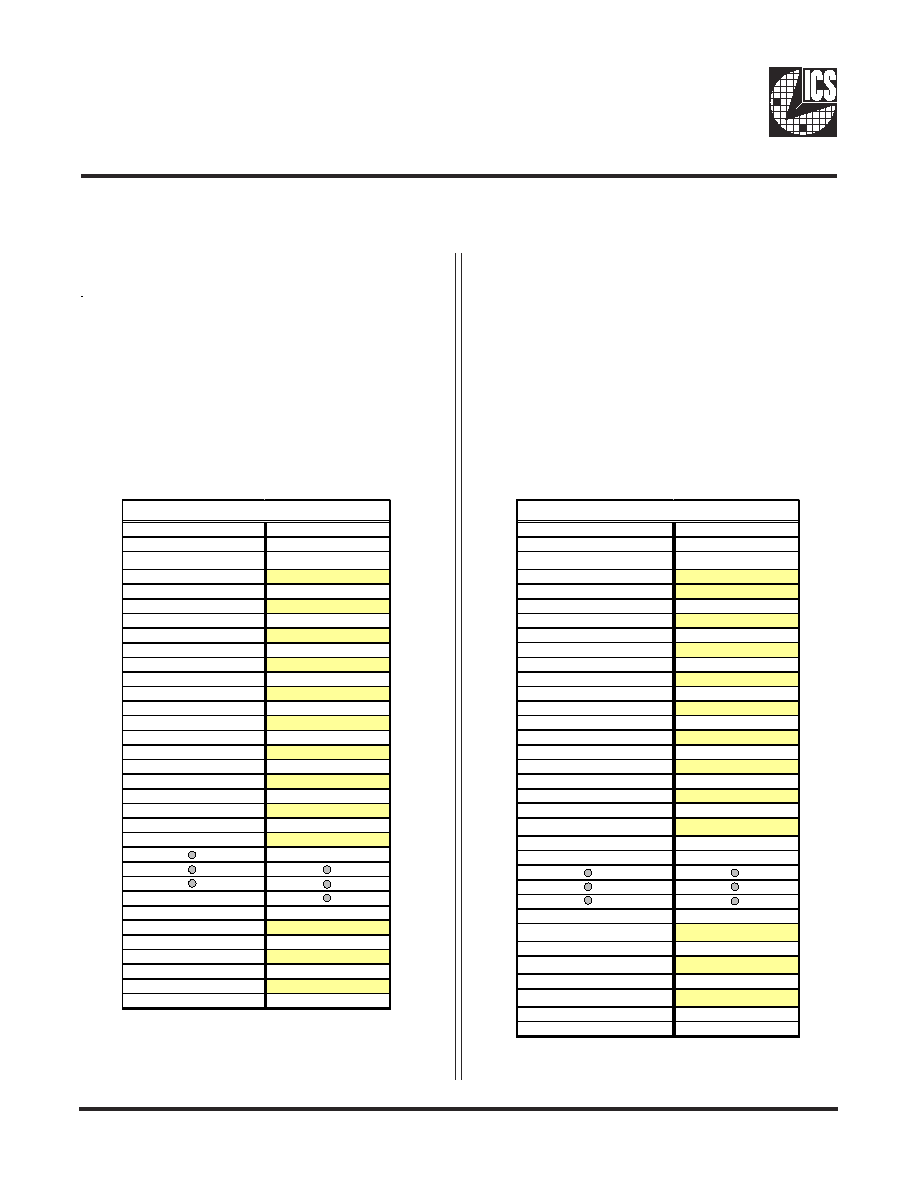
12
ICS951901
0670B--07/15/04
General I
2
C serial interface information for the ICS951901
How to Write:
· Controller (host) sends a start bit.
· Controller (host) sends the write address D2
(H)
· ICS clock will acknowledge
· Controller (host) sends a dummy command code
· ICS clock will acknowledge
· Controller (host) sends a dummy byte count
· ICS clock will acknowledge
· Controller (host) starts sending Byte 0 through Byte 28
(see Note 2)
· ICS clock will acknowledge each byte one at a time
· Controller (host) sends a Stop bit
How to Read:
· Controller (host) will send start bit.
· Controller (host) sends the read address D3
(H)
· ICS clock will acknowledge
· ICS clock will send the byte count
· Controller (host) acknowledges
· ICS clock sends Byte 0 through byte 6 (default)
· ICS clock sends Byte 0 through byte X (if X
(H)
was
written to byte 6).
· Controller (host) will need to acknowledge each byte
· Controller (host) will send a stop bit
*See notes on the following page
.
Controller (Host)
ICS (Slave/Receiver)
Start Bit
Address D2
(H)
ACK
Dummy Command Code
ACK
Dummy Byte Count
ACK
Byte 0
ACK
Byte 1
ACK
Byte 2
ACK
Byte 3
ACK
Byte 4
ACK
Byte 5
ACK
Byte 6
ACK
Byte 18
ACK
Byte 19
ACK
Byte 20
ACK
Stop Bit
How to Write:
Controller (Host)
ICS (Slave/Receiver)
Start Bit
Address D3
(H)
ACK
Byte Count
ACK
Byte 0
ACK
Byte 1
ACK
Byte 2
ACK
Byte 3
ACK
Byte 4
ACK
Byte 5
ACK
Byte 6
ACK
If 7
H
has been written to B6
Byte 7
ACK
If 1A
H
has been written to B6
Byte18
ACK
If 1B
H
has been written to B6
Byte 19
ACK
If 1C
H
has been written to B6
Byte 20
ACK
Stop Bit
How to Read:
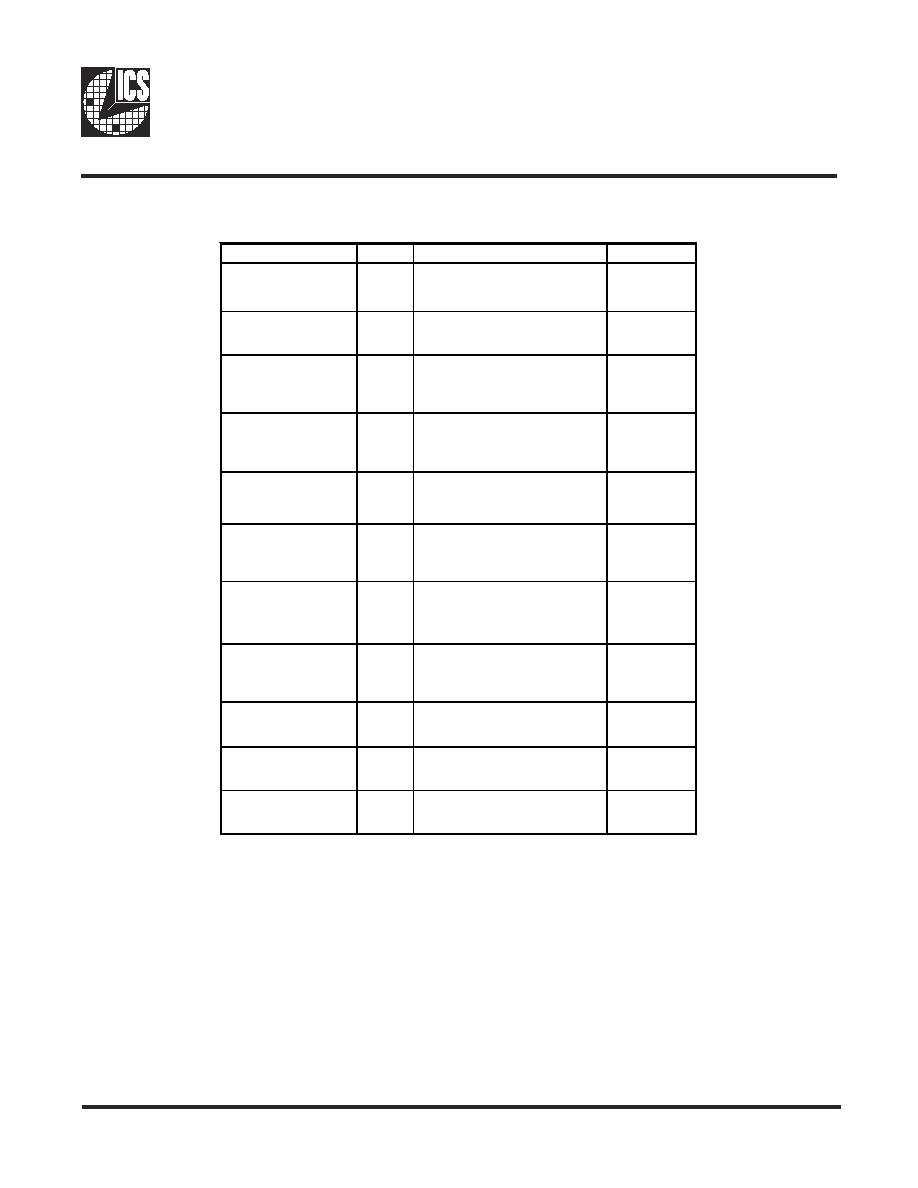
13
ICS951901
0670B--07/15/04
1.
The ICS clock generator is a slave/receiver, I
2
C component. It can read back the data stored in the latches
for verification. Readback will support standard SMBUS controller protocol. The number of bytes to
readback is defined by writing to byte 8.
2.
When writing to byte 11 - 12, and byte 13 - 14, they must be written as a set. If for example, only byte
14 is written but not 15, neither byte 14 or 15 will load into the receiver.
3.
The data transfer rate supported by this clock generator is 100K bits/sec or less (standard mode)
4.
The input is operating at 3.3V logic levels.
5.
The data byte format is 8 bit bytes.
6.
To simplify the clock generator I
2
C interface, the protocol is set to use only Block-Writes from the
controller. The bytes must be accessed in sequential order from lowest to highest byte with the ability to
stop after any complete byte has been transferred. The Command code and Byte count shown above must
be sent, but the data is ignored for those two bytes. The data is loaded until a Stop sequence is issued.
7.
At power-on, all registers are set to a default condition, as shown.
Notes:
Brief I
2
C registers description for ICS951901
Programmable System Frequency Generator
Register Name
Byte
Description
PWD Default
Functionality &
Frequency Select
Register
0
Output frequency, hardware / I
2
C
frequency select, spread spectrum &
output enable control register.
See individual
byte
description
Output Control Registers
1-6
Active / inactive output control
registers/latch inputs read back.
See individual
byte
description
Vendor ID & Revision ID
Registers
7
Byte 11 bit[7:4] is ICS vendor id -
1001. Other bits in this register
designate device revision ID of this
part.
See individual
byte
description
Byte Count
Read Back Register
8
Writing to this register will configure
byte count and how many byte will
be read back. Do not write 00
H
to
this byte.
08
H
Watchdog Timer
Count Register
9
Writing to this register will configure
the number of seconds for the
watchdog timer to reset.
10
H
Watchdog Control
Registers
10 Bit [6:0]
Watchdog enable, watchdog status
and programmable 'safe' frequency'
can be configured in this register.
000,0000
VCO Control Selection
Bit
10 Bit [7]
This bit select whether the output
frequency is control by
hardware/byte 0 configurations or
byte 11&12 programming.
0
VCO Frequency Control
Registers
11-12
These registers control the dividers
ratio into the phase detector and
thus control the VCO output
frequency.
Depended on
hardware/byte
0 configuration
Spread Spectrum
Control Registers
13-14
These registers control the spread
percentage amount.
Depended on
hardware/byte
0 configuration
Group Skews Control
Registers
15-16
Increment or decrement the group
skew amount as compared to the
initial skew.
See individual
byte
description
Output Rise/Fall Time
Select Registers
17-20
These registers will control the
output rise and fall time.
See individual
byte
description
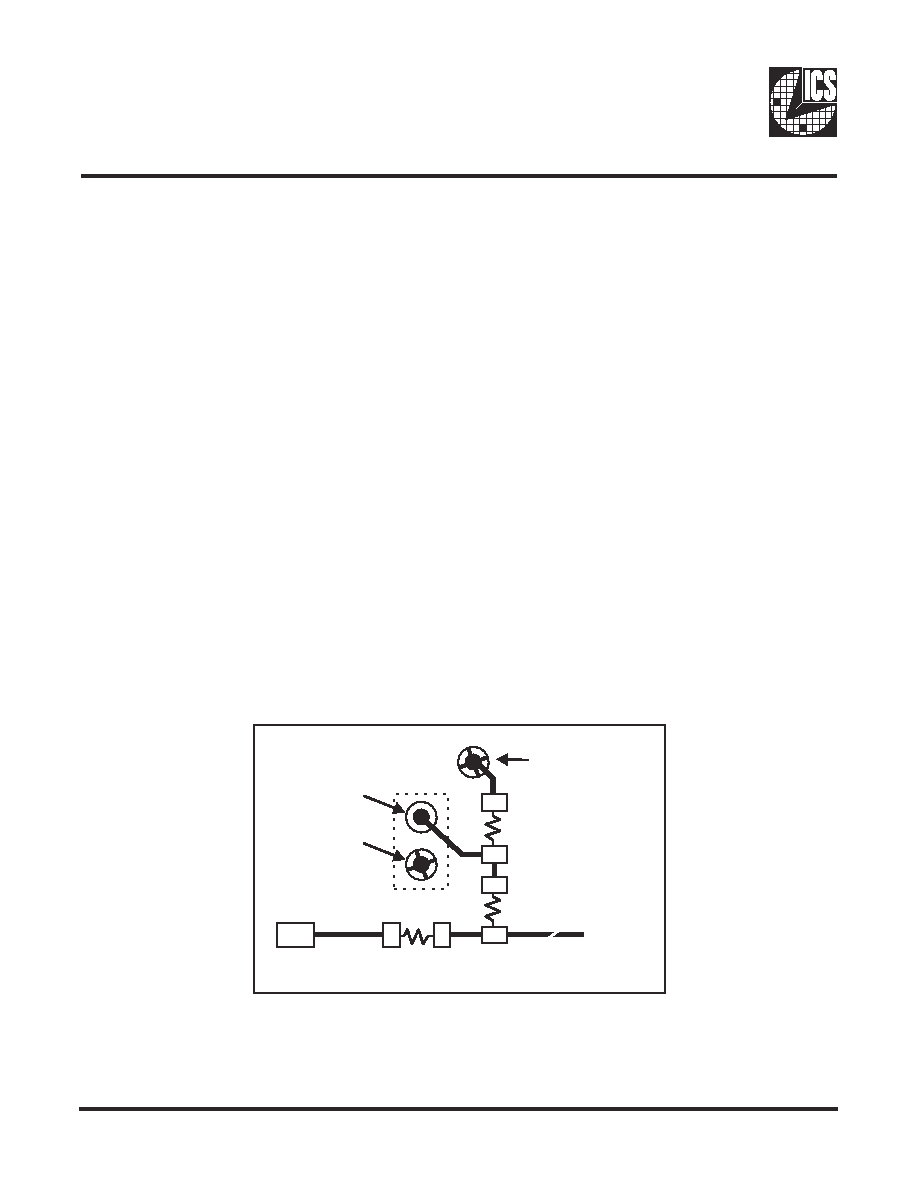
14
ICS951901
0670B--07/15/04
Fig. 1
Shared Pin Operation -
Input/Output Pins
The I/O pins designated by (input/output) on the ICS951901
serve as dual signal functions to the device. During initial
power-up, they act as input pins. The logic level (voltage)
that is present on these pins at this time is read and
stored into a 5-bit internal data latch. At the end of Power-
On reset, (see AC characteristics for timing values), the
device changes the mode of operations for these pins to
an output function. In this mode the pins produce the
specified buffered clocks to external loads.
To program (load) the internal configuration register for
these pins, a resistor is connected to either the VDD
(logic 1) power supply or the GND (logic 0) voltage
potential. A 10 Kilohm (10K) resistor is used to provide
both the solid CMOS programming voltage needed during
the power-up programming period and to provide an
insignificant load on the output clock during the subsequent
operating period.
Via to
VDD
Clock trace to load
Series Term. Res.
Programming
Header
Via to Gnd
Device
Pad
2K
W
8.2K
W
Figure 1 shows a means of implementing this function
when a switch or 2 pin header is used. With no jumper is
installed the pin will be pulled high. With the jumper in
place the pin will be pulled low. If programmability is not
necessary, than only a single resistor is necessary. The
programming resistors should be located close to the
series termination resistor to minimize the current loop
area. It is more important to locate the series termination
resistor close to the driver than the programming resistor.
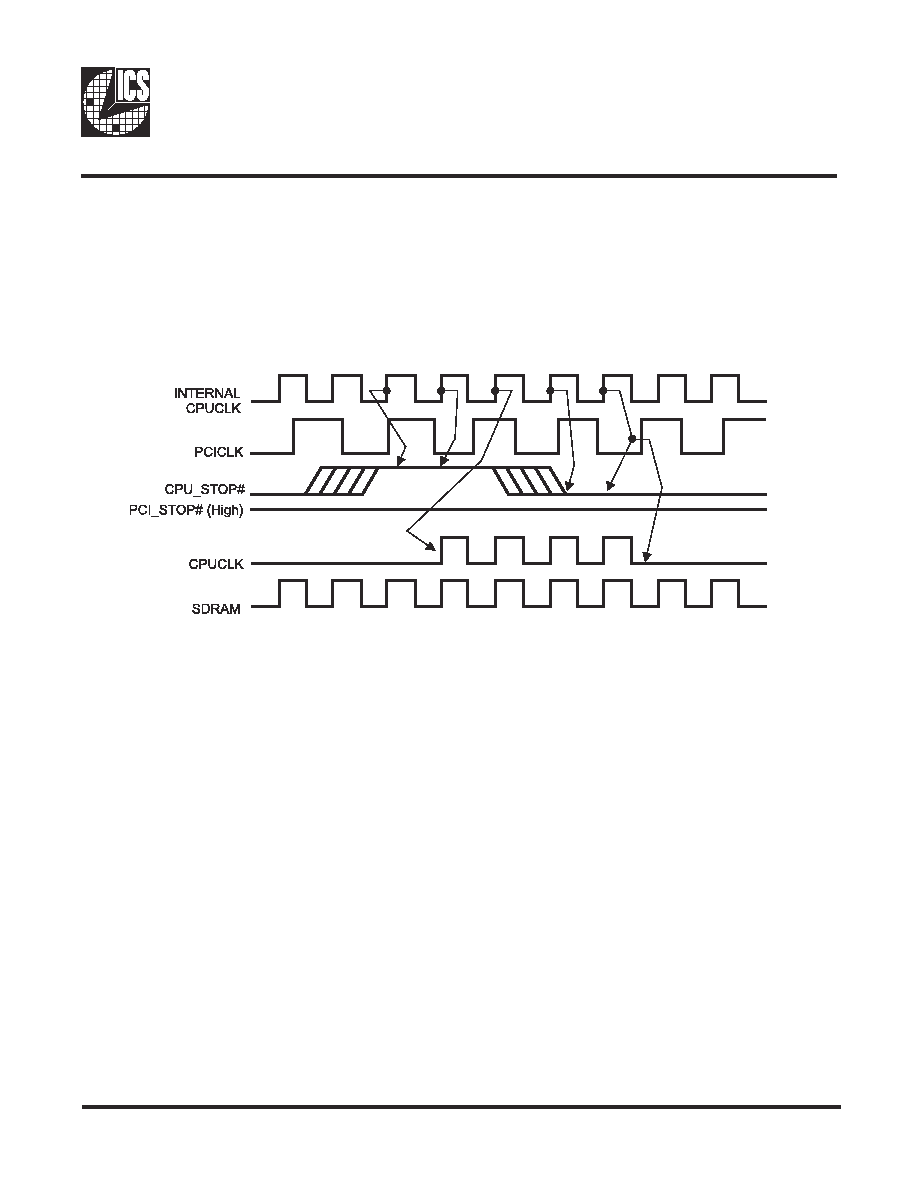
15
ICS951901
0670B--07/15/04
CPU_STOP# Timing Diagram
CPU_STOP# is an asychronous input to the clock synthesizer. It is used to turn off the CPU clocks for low power
operation. CPU_STOP# is synchronized by the ICS94209. The minimum that the CPU clock is enabled (CPU_STOP#
high pulse) is 100 CPU clocks. All other clocks will continue to run while the CPU clocks are disabled. The CPU clocks
will always be stopped in a low state and start in such a manner that guarantees the high pulse width is a full pulse.
CPU clock on latency is less than 4 CPU clocks and CPU clock off latency is less than 4 CPU clocks.
Notes:
1. All timing is referenced to the internal CPU clock.
2. CPU_STOP# is an asynchronous input and metastable conditions may exist. This signal is
synchronized to the CPU clocks inside the ICS94209.
3. All other clocks continue to run undisturbed. (including SDRAM outputs).
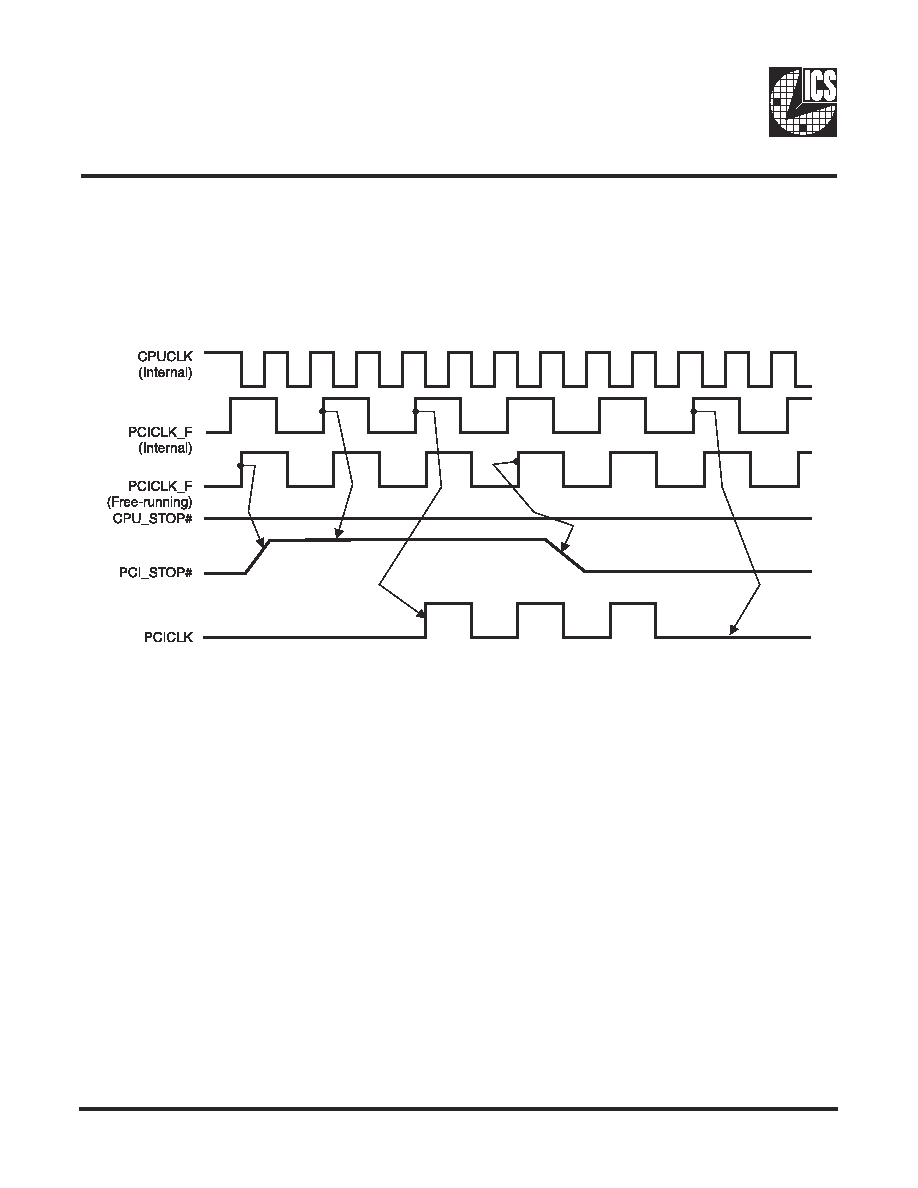
16
ICS951901
0670B--07/15/04
PCI_STOP# Timing Diagram
PCI_STOP# is an asynchronous input to the ICS94209. It is used to turn off the PCICLK clocks for low power operation.
PCI_STOP# is synchronized by the ICS94209 internally. The minimum that the PCICLK clocks are enabled
(PCI_STOP# high pulse) is at least 10 PCICLK clocks. PCICLK clocks are stopped in a low state and started with a
full high pulse width guaranteed. PCICLK clock on latency cycles are only one rising PCICLK clock off latency is one
PCICLK clock.
Notes:
1. All timing is referenced to the Internal CPUCLK (defined as inside the ICS94209 device.)
2. PCI_STOP# is an asynchronous input, and metastable conditions may exist. This signal is required to be synchronized
inside the ICS94209.
3. All other clocks continue to run undisturbed.
4. CPU_STOP# is shown in a high (true) state.

17
ICS951901
0670B--07/15/04
SDRAM_STOP# Timing Diagram
SDRAM_STOP# is an asychronous input to the clock synthesizer. It is used to stop SDRAM clocks for low power
operation. SDRAM_STOP# is synchronized to complete it's current cycle, by the ICS94209. All other clocks will
continue to run while the SDRAM clocks are disabled. The SDRAM clocks will always be stopped in a low state and
start in such a manner that guarantees the high pulse width is a full pulse.
Notes:
1. All timing is referenced to the internal CPU clock.
2. SDRAM is an asynchronous input and metastable conditions may exist. This signal is
synchronized to the SDRAM clocks inside the ICS94209.
3. All other clocks continue to run undisturbed.
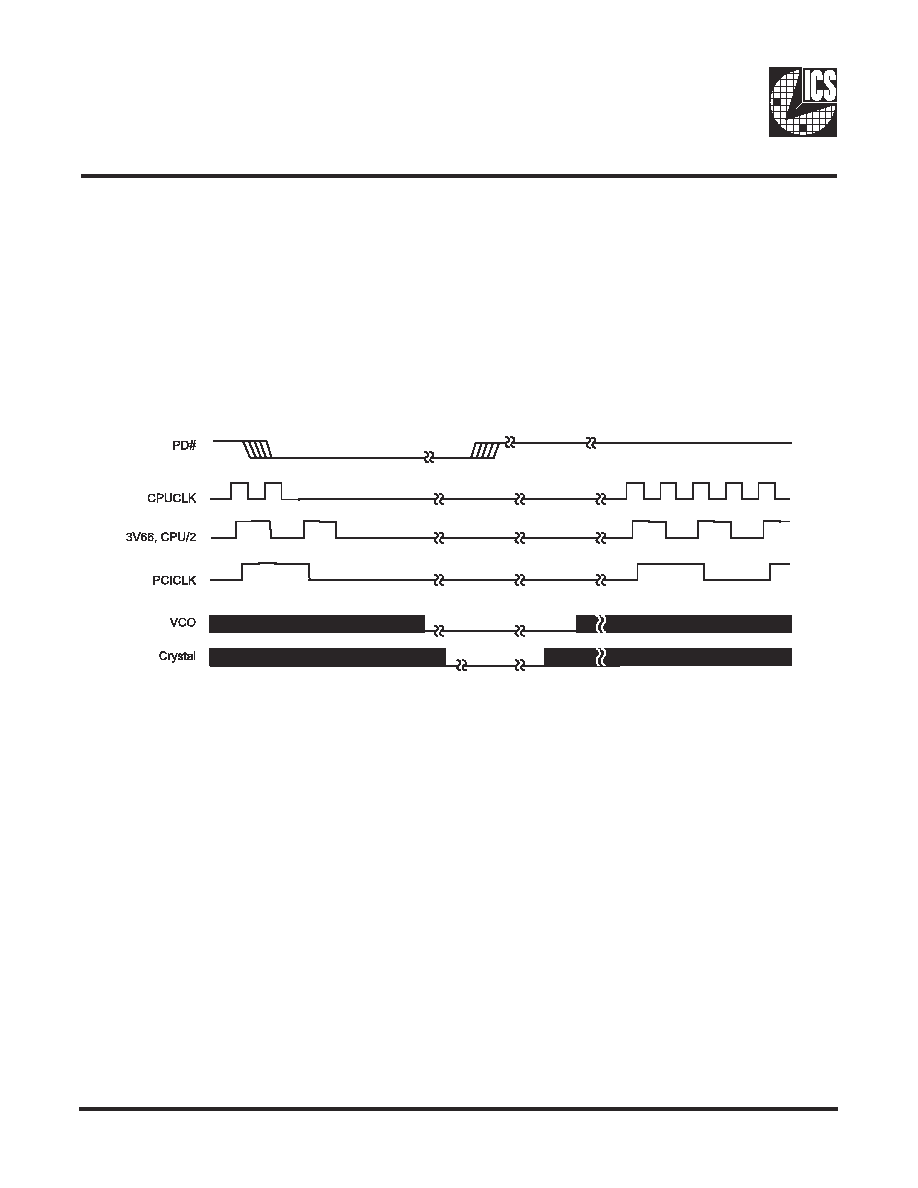
18
ICS951901
0670B--07/15/04
PD# Timing Diagram
The power down selection is used to put the part into a very low power state without turning off the power to the part.
PD# is an asynchronous active low input. This signal needs to be synchronized internal to the device prior to powering
down the clock synthesizer.
Internal clocks are not running after the device is put in power down. When PD# is active low all clocks need to be driven
to a low value and held prior to turning off the VCOs and crystal. The power up latency needs to be less than 3 mS.
The power down latency should be as short as possible but conforming to the sequence requirements shown below.
PCI_STOP# and CPU_STOP# are considered to be don't cares during the power down operations. The REF and 48MHz
clocks are expected to be stopped in the LOW state as soon as possible. Due to the state of the internal logic, stopping
and holding the REF clock outputs in the LOW state may require more than one clock cycle to complete.
Notes:
1. All timing is referenced to the Internal CPUCLK (defined as inside the ICS94209 device).
2. As shown, the outputs Stop Low on the next falling edge after PD# goes low.
3. PD# is an asynchronous input and metastable conditions may exist. This signal is synchronized inside this part.
4. The shaded sections on the VCO and the Crystal signals indicate an active clock.
5. Diagrams shown with respect to 133MHz. Similar operation when CPU is 100MHz.
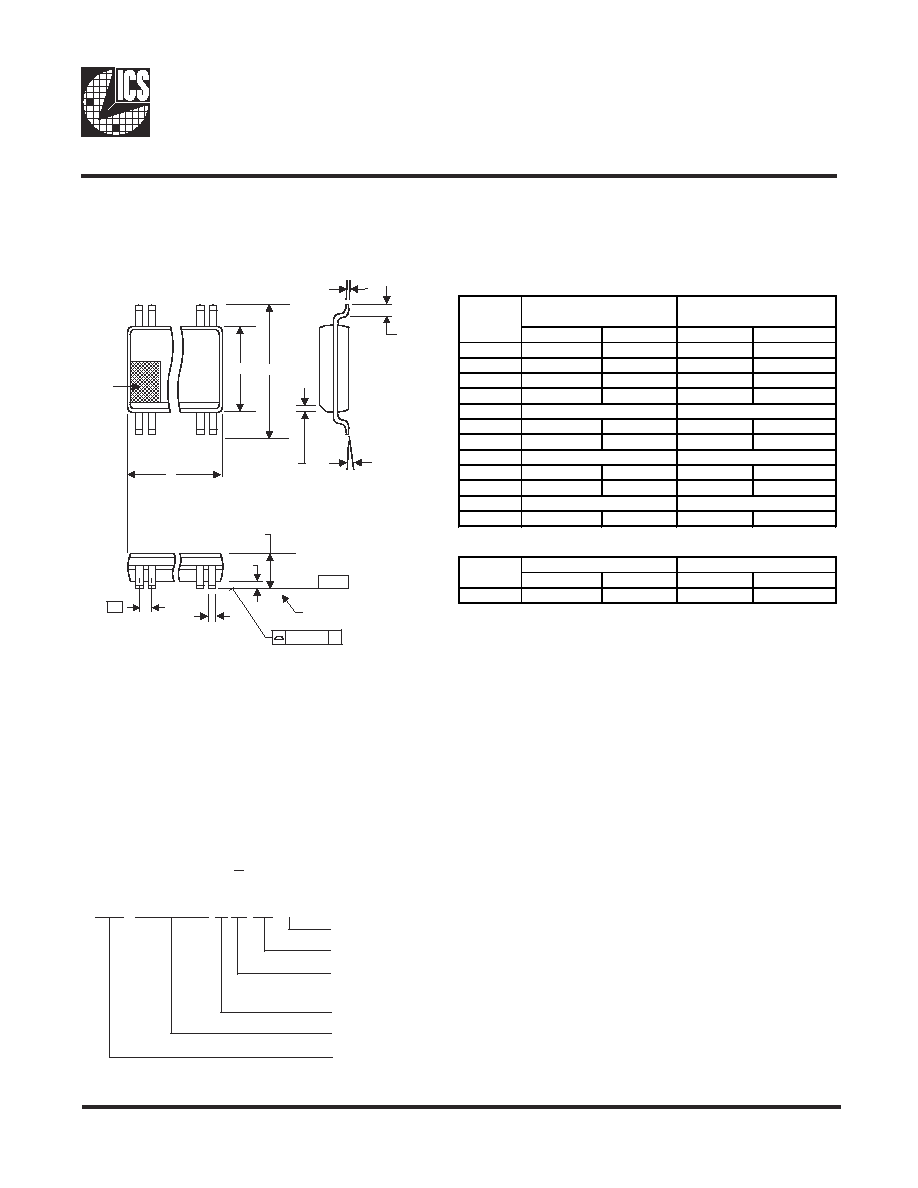
19
ICS951901
0670B--07/15/04
Ordering Information
ICS951901yFLF-T
INDEX
AREA
INDEX
AREA
1 2
1 2
N
D
h x 45°
h x 45°
E1
E
a
SEATING
PLANE
SEATING
PLANE
A1
A
e
- C -
- C -
b
.10 (.004) C
.10 (.004) C
c
L
300 mil SSOP Package
MIN
MAX
MIN
MAX
A
2.41
2.80
.095
.110
A1
0.20
0.40
.008
.016
b
0.20
0.34
.008
.0135
c
0.13
0.25
.005
.010
D
E
10.03
10.68
.395
.420
E1
7.40
7.60
.291
.299
e
h
0.38
0.64
.015
.025
L
0.50
1.02
.020
.040
N
0°
8°
0°
8°
MIN
MAX
MIN
MAX
48
15.75
16.00
.620
.630
10-0034
SYMBOL
In Millimeters
In Inches
COMMON DIMENSIONS
COMMON DIMENSIONS
SEE VARIATIONS
SEE VARIATIONS
0.635 BASIC
0.025 BASIC
Reference Doc.: JEDEC Publication 95, MO-118
VARIATIONS
SEE VARIATIONS
SEE VARIATIONS
N
D mm.
D (inch)
Example:
Designation for tape and reel packaging
Lead Free (Optional)
Package Type
F = SSOP
Revision Designator (will not correlate with datasheet revision)
Device Type
Prefix
ICS = Standard Device
ICS XXXXXX y F LF- T


















